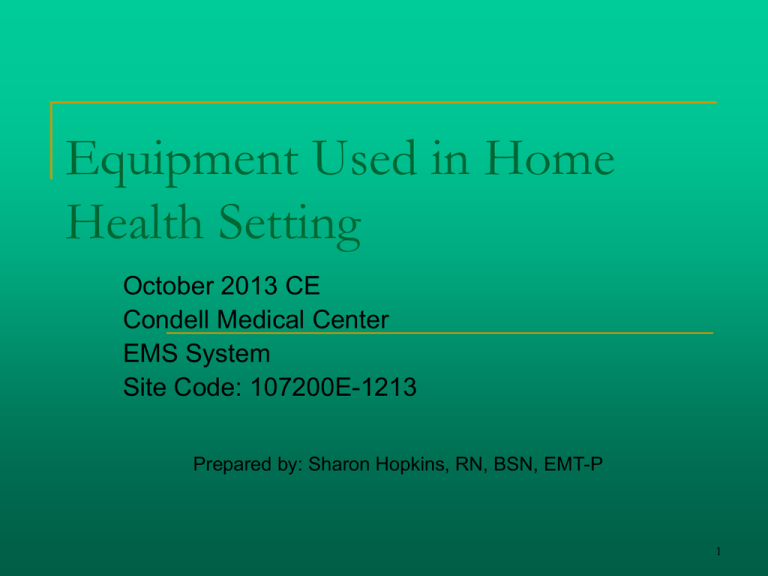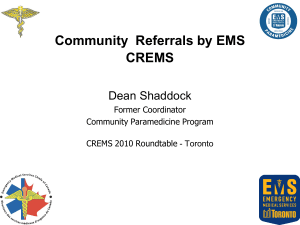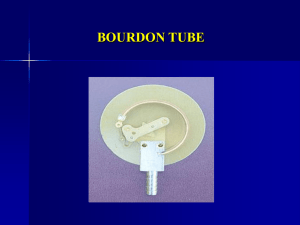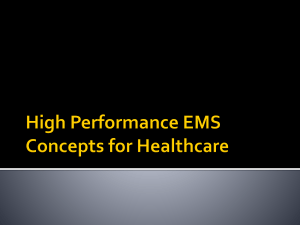
Equipment Used in Home
Health Setting
October 2013 CE
Condell Medical Center
EMS System
Site Code: 107200E-1213
Prepared by: Sharon Hopkins, RN, BSN, EMT-P
1
Objectives
Upon successful completion of this module,
the EMS provider will be able to:
Discuss population served by Home Health
Care or in need of specialized equipment.
Discuss the psychosocial concerns patients
experience when receiving home health care.
Describe various pieces of equipment used in
the home care population
Describe EMS care related to the piece of
equipment while transporting the patient
2
Objectives
Actively participate in case scenario
discussion.
Actively participate in review of equipment
typically present in the home setting of
chronically ill patients.
Successfully complete the post quiz with a score
of 80% or better.
3
Population Served by Home Health Care
A patient being discharged from an acute
care setting
To home
To skilled nursing facility
Nursing home
Assisted living
Rehabilitative services
Patient care continuing with some type of
device or specialized care required that
promotes health and well-being
4
Psychosocial Aspects of Home Health
Care Patients
Patient and caregiver(s) have received
education on the medical condition and
equipment
Use them as a resource – they may know better
Some patients are sick and tired of being sick
and tired
Patient and caregiver may not be at their best and
can be frustrated, angry, short tempered
We are caring for people who are at their lowest
Treat the patient and caregiver as you would want your
family member treated
5
EMS Interaction with Patients Receiving
Home Health Care
You may know more about medicine in
general but the patient and family/care giver
know more about the patient’s medical
condition and equipment than you do
(usually)
Use the resources at hand when dealing with
additional equipment that is foreign to you
6
Typical Equipment in the Home Health
Environment
Oxygen
Trach tubes
Ventilators
Central lines
PICC lines
NG tubes
PEG tubes
Dialysis
Foley catheters
Suprapubic tubes
Nephrostomy tubes
Ostomies
Colostomy
Ileostomy
Wound vacs
7
Home Oxygen
Patient on home oxygen would be transferred
to EMS O2 source
When turning off any O2 tank, bleed down the
valve
Prevents inadvertent leakage of oxygen through
an open system
Turn valve off (counter clockwise)
Turn up flow rate
When needle bleeds down to “0”, turn flow rate to “0”
Prevents damage to O ring
8
Oxygen Concentrator
Device resembles a dehumidifier and
concentrates oxygen from ambient gas
removing Nitrogen to deliver an oxygen rich
supply (approx 97-98%)
Typically can deliver
1 – 5 lpm of O2
This device allows the
patient unrestricted
mobility – can run on
batteries
Would be useful in a power outage
9
Tracheostomy
Surgical opening in the anterior wall of the trachea
to facilitate breathing
Air bypasses the pharynx and larynx
Generally, patients are unable to speak
May be taught/trained depending on trach tube size, design,
and condition of larynx
Can be placed when there is obstruction present
Used to obtain an airway due to injuries
or surgery to the head and neck area
Used to prevent the risk of aspiration
in patient with poor cough/gag reflex
10
Tracheostomy
Introduction of obturator
Similar to placing a QuickTrach
Tube being placed into
position in trachea
Trach tube in place
Inner cannula separated
from outer cannula
11
Tracheostomy
Potential complications
Loss of tube patency (i.e.: secretions, mucous
plugs)
Displacement of tube
Assessment
Signs / symptoms respiratory distress?
Decreasing oxygen saturation?
Tachycardia/bradycardia?
Hypotension?
Decreasing level of consciousness?
12
Tracheostomy
Typical equipment
Outer cannula inserted
into trachea
Cuff at distal tip protects
airway against aspiration
Cuff allows positive pressure ventilation
Some tubes are uncuffed for some populations
Inner cannula inserted through the outer
cannula
Device secured in place with trach ties
around the neck
13
Tracheostomy - Trach Tubes
Equipment may consist of a fenestrated (hole(s)
in tube) or non-fenestrated tube
Fenestrated tube facilitates ease of producing a
voice; used during the weaning process
Trach can also be “plugged” during weaning
Trach tubes have an inner cannula in place
Inner cannula removed
every day for cleaning
Spares are generally
kept with the patient
14
Tracheostomy
EMS care
Assess the patient’s airway status
Be prepared to assist with ventilations
BVM connects to universal 15mm proximal end of trach tube
Some long term trachs have shorter profiles that don’t connect
to BVM’s
Be prepared to suction patient
Limit time to 10 seconds per attempt
If possible, allow patient to
reoxygenate between suctioning
attempts
Enrich environment with blow-by O2
Hold O2 tubing next to trach
opening
15
Ventilators
Used for patients unable to ventilate / breath
on their own
Patient would have a tracheostomy (“trach”)
tube if home on a vent
Ventilators can be set to assist with the
patient's own breaths or totally control the
patient’s breathing
16
Ventilators
If patient must be transported, continue to
keep patient ventilated
If ventilator is small enough and can be
transported with patient, do so
If patient cannot be transported with ventilator,
would need to ventilate patient via BVM
Pay particular attention to maintain the patient
ventilation rate as set by ventilator
In absence of knowledge of pre-set rate, follow AHA
ventilation guidelines for advanced airway device
Neonate – 1 breath every second
Infant and child – 1 breath every 6 seconds
Adult – 1 breath every 6 seconds
17
Central Lines
These lines are placed in a large vein
Intended for long term use (i.e.: months or years)
Generally placed under general anesthesia by a
surgeon
Prevents repeated needle sticks through the skin
into a vein
Used to administer medication and fluids
directly into the bloodstream
Blood products can be administered
Blood for lab work can be withdrawn
18
Central Lines
Hickman or
Broviac
PICC line
Port-a cath
19
Central Lines – Hickman or Broviac
Long silicone catheter inserted into a large
vein (i.e.: superior vena cava) directly into the
heart
May be one or two separate lumen catheters
Cuff just under skin helps to anchor catheter
in place
Cuff also blocks bacteria from migrating into
bloodstream
Initially, visible sutures secure catheter in
place until cuff is adhered to tissue
Meticulous care necessary at exit site
20
Central Lines – Port-a cath
Port totally implanted under the skin providing
access to central venous circulation
Port has a reservoir with injectable septum
Port placed under general anesthesia by surgeon
Most placed under collarbone
Catheter attached to reservoir is threaded into large vein
leading to heart
May be placed under arm on chest wall or in abdominal
area
Port requires no special care for skin care
Device implanted below the skin surface
21
Central Lines - PICC
Peripherally inserted central line
May have single or multiple lumens
Inserted into a peripheral vein, generally in the
upper arm
Catheter advanced until tip terminates in a large vein in
the chest near the heart
Point of entry is from the periphery
Inserted under the benefit of ultrasound by
specially trained staff
Can remain in place for a longer duration than
other central or peripheral access devices
22
Central Lines – PICC cont’d
Used for
Prolonged antibiotic therapy
Medication administration
Prolonged nutrition
Chemotherapy
Blood draws for lab work
Home or sub-acute treatment at home for long
periods
Lower complication rates over alternative
central lines
23
PICC Lines
24
Central Lines and EMS Care
EMS must protect site from potential infection
Dressings should remain in place
Wet or loose dressings increase risk for infection
Avoid pulling/tugging on lines
NEVER access site
This is a central line
Some sites need specialized equipment
A meticulous protocol is followed to access
site
Appropriate PPE equipment is worn when
dressing changes are performed
25
Central Lines and EMS Care
Avoid obtaining B/P in arm cannulated with
PICC
Do not use scissors around the catheter site
to avoid inadvertently cutting the catheter
Avoid getting the dressing wet
Never flush the catheter for the patient
Catheters are flushed daily and must follow a set
protocol
Solutions may include saline and/or heparin
26
Nasogastric Tubes
This is a tube inserted
though the nose or mouth and
into the stomach
Used to allow drainage of the
stomach or to provide
nutrition when the patient is
unable to take oral food
and liquids themselves
J-tube (Dobhoff tube) is a
weighted tube that passes
through the stomach, past the pyloric sphincter, and
ends in the jejunum
27
Nasogastric (NG) Tubes
Typical patient
Any patient unable to swallow due to
change in anatomical structures or
for disease
EMS care
If tube is clamped off, leave it as is
If tube feeding in process and cannot be
disconnected, transport with patient in same
position (usually upright) and tube feeding bag at
same height
28
Nasogastric (NG) Tubes – EMS Care
Do not put anything into tube
Tube placement must ALWAYS be confirmed prior to
administering anything into it
Tube may have slipped from esophagus into the trachea
All medications must be well dissolved and in liquid form
If tubing is misclamped, may start leaking from ports
Cover end of tubing with gauze
Inform nurse upon arrival at hospital
If tube is not properly flushed when disconnected,
may become plugged
Inform ED staff if NG tube not flushed when disconnected
29
PEG Tube
Percutaneous endoscopic
gastrostomy
A soft, plastic tube inserted into
stomach through the abdominal wall
May be permanent or temporary
Typical patient
Patient unable to eat or drink and this allows for
feedings
May be fed via a syringe, gravity drip bag or
feeding pump
30
PEG Tube cont’d
Precautions
Skin care is required daily around insertion site
Hub of tube (tube opening) needs to be cleaned
daily
Tube must be flushed before and after each use
31
PEG Tube cont’d
EMS care
If PEG tube is clamped, leave clamp in place
Do not pull on tube
Bumper around end of tube should be flush and
snug to the skin
If tube feeding is in process, can maintain
equipment at same height and transport patient
If tube comes out, patient needs to have tube
replaced at hospital right away
Stoma can start to close within 2 hours
32
Dialysis
A life saving procedure to substitute for
normal duties of the kidneys
Filtering of waste products from blood
Regulation of the body’s fluid balance
2 types used
Hemodialysis
Mature, healthy fistula site can be used for many years
Peritoneal dialysis
33
Dialysis
Peritoneal
Hemodialysis
34
Dialysis cont’d
Typical patient
Patient in kidney failure
Can be an acute event or a chronic condition
Condition often monitored by measuring the blood
levels of creatinine and blood urea nitrogen (BUN)
Increasing levels indicate the decreasing ability of
kidneys to cleanse the body of waste products
35
Hemodialysis
Hemodialysis
Use of a special filter to remove
excess waste products and water
from the body
Blood passes from the patient's body through a
filter in the dialysis machine
A needle is placed into the graft or fistula
Blood is delivered to the dialysis machine
Blood is filtered
Blood is returned to
the patient
36
Hemodialysis
AV Fistula
Connection of a vein and an artery in your arm
Allows blood from body to be pulled out into dialysis
machine and then put back into the body
The physician assesses for the best site (i.e.: a
strong vein and artery)
T
ry
to
The fistula will most likely be needed for a long time
Graft
A plastic tube placed between an artery and a
vein in the arm or leg
37
Hemodialysis cont’d
Patients generally in treatment 3 times per
week on alternating days
Treatment lasts from
2½ to 41/2 hours
A working fistula is a
life insurance policy
38
Peritoneal Dialysis
Patient’s own body tissues inside abdominal
cavity act as the filter
Plastic tube placed though abdominal wall
into abdominal cavity
Special fluid flushed into abdominal cavity
and washes around the intestines
Intestinal wall acts as filter between fluid and
blood stream
Fluid drained out back into a collection bag
39
Peritoneal Dialysis cont’d
Patient has a major role in maintaining a
clean surface on the abdominal wall to
prevent infection
Each procedure takes 30 minutes to
accomplish
Procedure repeated 4 – 5 times a day 7 days
a week
As an alternative, patient may use a special
machine every night
5 – 6 bags of dialysis fluid used in the exchange
while the patient sleeps
40
Dialysis
Care by EMS
NEVER place tourniquets or B/P cuffs on
extremity with graft or fistula
NEVER start an IV in the extremity with a graft or
fistula
If peritoneal dialysis is in process, maintain bag at
same height
If draining into patient, will be elevated like an IV bag
If draining from patient, will be lower than the patient's
waist
41
Foley Catheter
Closed drainage system device to drain the
urinary bladder
Catheter is placed through the urethra into the
bladder
A water filled balloon holds the catheter in place
External tubing then secured to the patient
Typical patient
Debilitated patient
Comfort to keep patient clean and dry and free
from skin breakdown due to exposure to
urine
Non-functioning urinary system
42
Foley Catheters cont’d
Indications
Need to drain the bladder of urine
Catheter allows for continuous drainage of urine
Catheter held in place by water filled balloon at
end of tube inserted into bladder via the urethra
Usually 10 ml of
saline/water in
balloon
43
Urine Drainage Bags
Bedside drainage bag
Usually worn when at home
Typically worn at night
Caution with length of tubing that it does not get
“caught” on anything
Leg bag
Typically worn when out
of the house
Usually secured with
straps to the leg
44
Foley Catheter cont’d
Care by EMS
NEVER pull on foley catheter
ALWAYS keep drainage bag below the level of the
patient’s waist
Prevents back flow of urine into bladder to reduce the
risk of infection
Do NOT lay drainage bag on floor
Catheter often secured to the patient’s thigh or
abdomen without tension on the tubing
45
Suprapubic Catheters
Surgically implanted catheter through the
abdominal wall and into the urinary bladder
Held in place with water filled balloon
46
Suprapubic Catheters
Typical patient
Alternative route used when a catheter cannot be
passed through the urethra due to obstruction
Can be used for patients with a neurogenic
bladder
Bladder does not contract to empty urine
Often found in patients with spinal cord injury
Indications
Used for long term use to drain the urinary
bladder
47
Suprapubic Tubes cont’d
EMS care
NEVER pull on foley catheter
ALWAYS keep drainage bag below the level of the
patient’s waist
Prevents back flow of urine into bladder to reduce the
risk of infection
Do NOT lay drainage bag on floor
48
Nephrostomy Tubes
Urinary drainage device surgically implanted
into the renal pelvis of the kidney
Consists of a nephrostomy tube and a
collection bag
Typical patient
Used in patients with some form of kidney disease
Allows for drainage of urine from the kidney when
normal urinary flow is impeded or obstructed
Often used for urinary obstruction such as a renal stone
49
Nephrostomy Tubes
Indications
Permits drainage of urine
from the kidneys
Catheter tube may be
sutured in place or
secured with velcro-like
device to a wafer
dressing similar to ostomies
Precaution
Increased risk of infection due to direct pathway
to the kidney
50
Nephrostomy Tubes
EMS care
NEVER pull on foley catheter
ALWAYS keep drainage bag below the level of the
patient’s waist
Very important to prevent accidently pulling tube out
Taping often used to minimize tension and to prevent
dislodging
Prevents back flow of urine into bladder to reduce
the risk of infection
Do NOT lay drainage bag on floor
51
Ostomies
Ostomies are artificially created openings to the
abdominal wall to allow the organ to continue to
function and excrete waste products
Colostomy (large intestine), ileostomy (small intestine),
urostomy (urinary system)
May be temporary or permanent
Most patients wear an appliance over the stoma to
collect the waste product
Stomas are typically red, moist and protruding in
appearance
No nerve endings in a stoma
Patients usually have no control over when and where stool
or urine is passed
Consistency of drainage dependent on location of ostomy
52
Ostomies
Typical patient
Patient with disease in the organ that needed
surgical resection of a part of that organ
Indications
To relieve the body of stool or urine, depending on
nature of ostomy
Usually placed due to obstruction or disease in
which part of the organ was removed
53
Review – Anatomy of the Colon
The colon is identified in sections
See previous slide
The large intestine includes the cecum,
colon, rectum and anal canal
A function of the large colon is to absorb
water, sodium and some fat soluble vitamins
and recycle back to the body as waste
products are propelled through the 15 feet
Stool becomes more solid as it moves
through the descending colon
54
Ostomy Care & EMS
EMS care
Do not put pressure on the
collection bag
May cause the bag to rupture and
spill contents
Transport the patient with the
bag intact
If a caregiver wants to empty the bag prior to EMS
departure from the scene, they may do so if the
delay is acceptable to EMS
EMS should refrain from attempting to empty ostomy
pouches
55
Ostomy Care & EMS cont’d
Extra supplies should be transported to the
hospital with the patient, if possible
The patient may need a change of supplies and
the receiving hospital may not have their skin
barrier product or bag in compatible sizes or
material
56
Wound Vac Therapy
A negative pressure wound therapy system
designed to promote wound healing though
granulation tissue formation
With use of a special foam dressing in the
wound, mechanical forces are applied to the
wound to create an environment that
promotes wound healing
57
Wound Vac cont’d
Wound edges are drawn together
Complete wound bed contraction is induced
Negative pressure is evenly distributed
Exudate and infectious material is removed
At the cellular level, edema is reduced and
perfusion is promoted
Tissue healing is promoted
Dressing changes occur several times per
week
58
Wound Vac System
During dressing changes, foam cut to size
Foam placed in wound
Wound site covered with suction device
Transparent dressing placed over site
59
Wound Vac cont’d
Typical patient
Patient with an open wound that will be healing
from the inside out
Black foam dressing is visible through a clear
dressing applied over wound
Device is run by an electric vacuum pump
Leave dressing intact
and unplug unit and
transport unit with patient
Unit will run on batteries
60
Wound Vac System
EMS implications
Suction will continue to be applied via battery
power on the device
Suction needs to be maintained
Foam cannot be left in wound for long periods without
suction
Trained care giver would change dressing if suction off for
longer than an hour or two
Foam dressing removed and wet-to-dry dressings placed
Avoid pulling on suction tubing
Inform ED staff that patient has a wound vac
system
61
Excited Delirium
Not a diagnosis but a state
A collection of an acute onset of symptoms
from varied and severe underlying processes
Characterized by
Extreme agitation
Hyperthermia
Hostility
Exceptional strength and endurance without
apparent fatigue
62
Morrison and Sadler 2001
Excited Delirium cont’d
Recognized for past 10 years
Typically associated with use of drugs that
alter the dopamine processing in the brain
At risk persons
96-99% males
Generally 31 – 44 years old
Usually involves a struggle
Death follows bizarre behavior and use of illegal
drugs
63
Excited Delirium cont’d
Can mimic
Don’t make assumptions
Use critical thinking skills to think of all
possibilities
Head injury
Hyperthermia
Meningitis
Autism
Avoid tunnel vision in forming general impression
One study identified fatal outcomes as rare
BUT…when they do occur, litigation can be costly
64
Excited Delirium cont’d
4 phases
Profuse sweating
Delirium with agitation
Respiratory arrest
Cardiac arrest
Officers struggling with the patient are often
unaware that the patient has stopped
struggling & screaming and has arrested
Post mortem autopsies often report negative
toxicology reports
Drug use does not have to be concurrent with behavior
65
Excited Delirium – Behavioral Cues
Intense paranoia
Extreme agitation
Disoriented about time, place, purpose
Unable to be talked down
Screaming
Pressured, loud, incoherent speech
Grunting, guttural sounds
Talking to invisible people
Irrational speech
66
Excited Delirium – Behavioral Cues
Violent behavior
Bizarre behavior
Aggression toward objects (glass, shiny
objects)
Runs into traffic
Naked
Reduced sensation to pain
67
Excited Delirium – Behavioral Cues
Super human strength
Seemingly unlimited endurance
Resists violently
Capture
Control
Restraint
68
Excited Delirium –
Physical Characteristics
Dilated pupils
Lid lift (eyes wide open)
Profuse sweating
Hyperthermia (not always present)
High core body temperature (1030 – 1100)
Skin discoloration
Large belly
Foaming at mouth
Uncontrollable shaking
Respiratory distress
69
Excited Delirium - Cascade of Events
Hyperthermia
Hypoventilation
Rhabdomyolysis
Breakdown of skeletal muscle tissue (i.e.: during
struggle)
Myoglobin (muscle protein) leaks into urine
Can plug the filtering tubes of the kidneys and cause
kidney failure
Muscle injury can leak potassium into the blood
causing hyperkalemia (cardiac irritant!!!)
70
Cascade of Events cont’d
Acidosis
Excess build of waste products not being excreted in form
of CO2 when hypoventilation occurs
Death may not be immediate
Rapid and aggressive medical intervention
(i.e.: sedation) necessary even in presence of only a
few behavioral cues
Important for accurate body temperature to be
documented as soon as possible (field or ED)
71
Excited Delirium – EMS Response
Helpful to dialogue ahead of time with local
PD regarding respective action with patient
Need to have a high index of suspicion
Patient needs sedation as soon as possible
EMS will need to stage until scene is safe
PD will need to physically capture, control,
and restrain patient
Then EMS can make patient contact to
provide sedation
72
Excited Delirium – EMS Response
EMS intervention VERY tough!!!
Prior to administration of medications, you are
asked to perform some form of patient
assessment and obtain vital signs
This is not the kind of patient vital signs will be
easy to obtain
Do the best you can
A life saver to the patient with excited delirium is
sedation
Need to control patient stress and exertions
73
Region X SOP – Behavioral Emergencies
Drug Administration
For SEVERE anxiety or agitation
Versed 2mg IN
May repeat Versed 2mg IN every 2 minutes titrated to
desired effect
Maximum total dose 10 mg
If additional sedation required
Valium 5 mg IVP over 2 minutes
May repeat as needed
Maximum total dose of 10mg
Valium 10 mg IM may be given as alternative to IVP
74
Case Scenario #1
EMS is called to the scene for a 72 year-old
patient with a dislodged foley catheter
Upon arrival the patient points to the foley
catheter, with balloon intact
How would you care for this patient???
75
Case Scenario #1 – Discussion Questions
Would you reinsert the foley catheter?
No
This must be done under sterile technique and by
trained persons
Does this patient require special care while
transporting them?
No
If there is bleeding present at the urethral
opening, cover with a dressing
76
Case Scenario #1
If your patient had an indwelling
catheter to drain urine, how
should you handle the
equipment during transport?
Keep the drainage bag below the level of the
patient's waist
Do NOT want urine to flow back
into the bladder
77
Case Scenario #2
EMS is called to the scene for a patient with a
plugged trach tube
What care are you anticipating the patient
may need to relieve the obstruction???
78
Case Scenario #2
To relieve a plugged trach tube
Consider suction
Advance catheter until patient starts to cough
Suctioning should be non-painful
Usually triggers coughing which also helps loosen
secretions
Limit suction time to max of 10 seconds
May need to ventilate the patient via BVM
Neonate - 1 breath per second
Infant and child – 1 breath every 6 seconds
Adult – 1 breath every 6 seconds
79
Case Scenario #3
EMS is called to the scene of a patient with a
wound vac
Power has been lost to the house
Is it important for this patient to be connected
to a power source or can they wait indefinitely
for power to resume???
Wound vac must be connected to a power source
to run; patient can tolerate 1-2 hours off suction
Wound vac will run on batteries
80
Case Scenario #3
What to do with a wound vac when power is lost
If negative pressure is not maintained in the wound,
the black foam needs to be removed
The patient would receive a wet to dry dressing in
the absence of constant suction being applied
This dressing would be applied by a trained person after
removal of the black foam
EMS should transport the patient
Stress to ED staff that patient has a wound vac in place
Staff can alert in-house resources for assistance if
needed
81
Case Scenario #4
EMS is called to the scene for a patient
bleeding from their colostomy site
Colostomy is established
Means not new for the patient
The patient history includes being on xarelto
82
Case Scenario #4 – What’s the rhythm?
Atrial fibrillation
Irregularly irregular rhythm
No discernible P waves
Distinctive palpable pulse (varied levels of
strength)
83
Case Scenario #4
Why would patient be bleeding???
Irritation at site
Active GI bleed
Effects of xarelto
What is xarelto???
Blood thinner used to minimize risk of stroke in
patient with atrial fibrillation
Additional blood thinners: coumadin (warfarin),
pradaxa (dabigatran), eliquis (apixaban)
84
Case Scenario #4
What should EMS do???
Apply pressure to site, if required, based on
amount of bleeding
Do not attempt to change equipment for
patient
85
Case Scenario #4
Due to patient history of atrial fibrillation (afib), what
are implications to EMS?
Increased risk for stroke due to blood clot formation
Increased risk of bleeding due to use of blood
thinners
Report whether a fib is potentially of new onset or
long standing
86
Case Scenario #5
You have responded to the scene for a naked
patient yelling and screaming and acting
bizarre
EMS has staged while PD is on the scene
Once able, what medication is used for
patient sedation?
Versed 2 mg IN every 2 minutes
Can titrate to 10 mg
If additional sedation required, Valium 5 mg IVP
87
Case Scenario #5
What are the benefits of administering a
medication via the IN route?
Avoids risk with a needle exposure
How is a medication administered via the IN
route?
Plunger needs to be pushed fast enough to create
a mist
Dose may be divided per nares to increase
surface absorption space
Max volume is 1 ml per nares
88
Case Scenario #6
EMS responds to a call for a patient not
feeling well
Upon arrival there is evidence of specialized
equipment in use
The caregiver “just ran an errand”
The patient is not sure what their equipment
is or what it is used for
89
Case Scenario #6 – Trivia Challenge
If you saw this piece of equipment, what do
you think it is?
What is it used for?
Colostomy on ascending colon
Port for body excretions
Are there any special precautions during
patient transport?
If no collection bag, cover with
trauma dressings and chux
Anticipate stool to be more liquid
90
Case Scenario #6 –
Trivia Challenge
If you saw this piece of
equipment, what do you think it is?
What is it used for?
Nephrostomy tube
Drains urine from the kidney
Are there any special precautions during
patient transport?
Avoid pulling on tube
If drain bag connected, keep lower than pt waist
91
Case Scenario #6 –
Trivia Challenge
If you saw this arm, what
would you think?
What is it used for?
A fistula or shunt is present
For access for hemodialysis
Are there any special precautions during
patient transport?
No B/P or IV sticks to that extremity
92
Case Scenario #6 –
Trivia Challenge
If you saw this piece of
equipment, what do you
think it is?
What is it used for?
A PICC line
For access to central circulation
Are there any special precautions during
patient transport?
Do not pull on the tubing
Do not increase any risk of infection to the line
Do not access lines!!!
93
Case Scenario #6 – Trivia Challenge
What’s this rhythm?
Sinus bradycardia with first degree heart block
First degree is a CONDITION of a rhythm; not a true rhythm by itself!!!
Any EMS implications?
Is patient stable or unstable?
What is the level of consciousness & B/P???
94
Case Scenario #6 – Trivia Challenge
What’s this rhythm?
Second degree Type I - Wenckebach
Any EMS implications?
Can be a normal rhythm in some people
Patients rarely symptomatic due to this rhythm
If patient symptomatic, keep looking for another cause
95
Case Scenario #6 – Trivia Challenge
What 4 rhythms found in the adult population
could cause an irregular pulse?
Atrial fibrillation – always irregular
Atrial flutter – may or may not be irregular
Premature beats – PVC, PAC, PJC
Check for meds including digoxin and blood thinners
Think PVC’s if cardiac or COPD patient
Think PAC’s if stimulants in younger person
First degree Type I Wenckebach
PR intervals get longer, longer, longer until there is a
dropped QRS
96
Home Health Equipment and EMS
Basically…
If it’s a tube protruding out – don’t pull on it
If it’s in a bag, don’t put pressure on the bag
Don’t want the bag to rupture and spill its contents
If you can transport the patient to the hospital with
all connections intact, do so
If there is a caregiver present who can assist, use
them
They are usually very familiar with the equipment and
processes for handling it
97
Bibliography
Bledsoe, B., Porter, R., Cherry, R. Paramedic Care
Principles & Practices, 4th edition. Brady. 2013.
Limmer, D., O’Keefe, M. Emergency Care 12th
Edition. Brady. 2012.
Region X SOP’s; IDPH Approved January 6, 2012.
Lt. Michael Paulus, Southwest District Commander;
Champaign, Illinois
www.exciteddelirium.org
http://www.med.uottawa.ca/procedures/ucath/
https://patienteducation.osumc.edu/documents/fene
str.pdf
98
Bibliography
http://www.ucdenver.edu/academics/colleges/medic
alschool/departments/medicine/hcpr/cauti/document
s/Sample%20Policy%20and%20Procedures.pdf
http://www.phoenixuoaa.org/protected/yourcomplete-recovery-from-ostomy-surgery
http://www.medicinenet.com/dialysis/article.htm
http://www.nhsggc.org.uk/content/default.asp
?page=s1214_12_2
http://www.alsfrombothsides.org/trachcare.ht
ml
99








